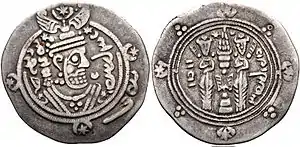761
Year 761 (DCCLXI) was a common year starting on Thursday (link will display the full calendar) of the Julian calendar. The denomination 761 for this year has been used since the early medieval period, when the Anno Domini calendar era became the prevalent method in Europe for naming years.
| Millennium: | 1st millennium |
|---|---|
| Centuries: | |
| Decades: | |
| Years: |
| 761 by topic |
|---|
| Leaders |
| Categories |
|
| Gregorian calendar | 761 DCCLXI |
| Ab urbe condita | 1514 |
| Armenian calendar | 210 ԹՎ ՄԺ |
| Assyrian calendar | 5511 |
| Balinese saka calendar | 682–683 |
| Bengali calendar | 168 |
| Berber calendar | 1711 |
| Buddhist calendar | 1305 |
| Burmese calendar | 123 |
| Byzantine calendar | 6269–6270 |
| Chinese calendar | 庚子年 (Metal Rat) 3457 or 3397 — to — 辛丑年 (Metal Ox) 3458 or 3398 |
| Coptic calendar | 477–478 |
| Discordian calendar | 1927 |
| Ethiopian calendar | 753–754 |
| Hebrew calendar | 4521–4522 |
| Hindu calendars | |
| - Vikram Samvat | 817–818 |
| - Shaka Samvat | 682–683 |
| - Kali Yuga | 3861–3862 |
| Holocene calendar | 10761 |
| Iranian calendar | 139–140 |
| Islamic calendar | 143–144 |
| Japanese calendar | Tenpyō-hōji 5 (天平宝字5年) |
| Javanese calendar | 655–656 |
| Julian calendar | 761 DCCLXI |
| Korean calendar | 3094 |
| Minguo calendar | 1151 before ROC 民前1151年 |
| Nanakshahi calendar | −707 |
| Seleucid era | 1072/1073 AG |
| Thai solar calendar | 1303–1304 |
| Tibetan calendar | 阳金鼠年 (male Iron-Rat) 887 or 506 or −266 — to — 阴金牛年 (female Iron-Ox) 888 or 507 or −265 |

Silver dirham of Khurshid II (734–761)
Events
Britain
- August 6 – Battle of Eildon: King Æthelwald Moll of Northumbria faces a rebellion, under a rival claimant to the throne named Oswine, brother of the murdered King Oswulf of Northumbria. Oswine is killed after a three-day battle against the forces of Æthelwald in Scotland.[1]
- Bridei V succeeds his brother Óengus I as king of the Picts (modern Scotland).[2]
Europe
- The city of Oviedo (Northern Spain) is founded by the monks Nolan and John (approximate date).
- Construction is completed on the 108-room Castello di Lunghezza outside of Rome, Italy.
Abbasid Caliphate
- An Abbasid Caliphate army reconquers the city of Kairouan (in modern-day Tunisia), from 'Abd al-Rahmān ibn Rustam of the Rustamid dynasty. The latter is forced to flee west, where he creates an autonomous state around Tihert (Tiaret).[3]
- Khurshid II, the last ruler (spāhbed) of Tabaristan, poisons himself when he learns that his family has been captured by the Abbasids.[4]
Asia
- The Japanese priest Dōkyō cures Empress Kōken by using prayers and potions. He may have become her lover and certainly becomes her court favorite, arousing the jealousy of Emperor Junnin.
- A great Chinese famine in the Huai-Yangtze area, late in the year, drives many people to cannibalism (approximate date).
Births
- Shun Zong, emperor of the Tang Dynasty (d. 806)
- Wu Chongyin, general of the Tang Dynasty (d. 827)
Deaths
- December 23 – Gaubald, bishop of Regensburg
- Donngal mac Laidcnén, king of the Uí Ceinnselaig (Ireland)
- Ibn Ishaq, Arab historian and hagiographer (or 767)
- Khurshid II, ruler (spāhbed) of Tabaristan (b. 734)
- Óengus I, king of the Picts[5]
- Shi Siming, general of the Tang Dynasty (b. 703)
- Empress Xin of China (b. unknown date)
References
- Kirby, p. 151, states that Oswine's origins are unknown. Marsden, pp. 232–233, suggests he was a son of Eadberht. The description of Oswine as an ætheling comes from John of Worcester's chronicle.
- Forsyth, Katherine (2000). "Evidence of a lost Pictish source in the Historia Regum Anglorum". In Taylor, Simon (ed.). Kings, clerics and chronicles in Scotland, 500–1297: essays in honour of Marjorie Ogilvie Anderson on the occasion of her ninetieth birthday. Dublin: Four Courts Press. ISBN 1-85182-516-9.
- Meynier, Gilbert (2010). L'Algérie cœur du Maghreb classique: De l'ouverture islamo-arabe au repli (658-1518). Paris: La Découverte. p. 25.
- Rekaya, M. (1986). "Khurshīd". The Encyclopedia of Islam. V (New ed.). Leiden; New York: Brill. pp. 68–70. ISBN 90-04-07819-3. Retrieved January 31, 2013.
- Lynch, Michael (ed.). The Oxford companion to Scottish history. Oxford University Press. p. 448. ISBN 9780199693054.
This article is issued from Wikipedia. The text is licensed under Creative Commons - Attribution - Sharealike. Additional terms may apply for the media files.